Bike Ride Bench Break Photo Tweet
On a midday bike ride bench break. Gorgeous even hot fall day; deep-blue sky over the Great Gray Bridge, not a cloud pic.twitter.com/keHAPlJ7lW
— Philip Turner (@philipsturner) October 2, 2013
On a midday bike ride bench break. Gorgeous even hot fall day; deep-blue sky over the Great Gray Bridge, not a cloud pic.twitter.com/keHAPlJ7lW
— Philip Turner (@philipsturner) October 2, 2013
A fascinating article with photos in Gothamist.com by Evan Bindelglass, covering the history and restoration of the bridge that connected the Bronx and Manhattan beginning in 1842, an interboro link across the Harlem River that was built to bring fresh water via the Croton Aqueduct in to Gotham. The span connects 170th Street in the Bronx to 173rd Street in Manhattan. In a deliciously arcane example of NYC geography, Bindelglass points out, that’s “West 173rd Street and not East,” though this is the east side of the island, “Because it is technically west of 5th Avenue,” the east-west midpoint of the island for road-naming purposes.
High Bridge has undergone numerous reconstructions over the decades. The current renovation–a joint project of NYC’s Parks Department and the NYC Department of Design and Construction–will allow the deck to reopen to pedestrians and cyclists upon its hoped-for completion in June 2014. In a suggestion that would delight many New Yorkers, Bindelglass reports,
“Some are already hailing the High Bridge as another High Line-like project. ‘Long linear spaces [are] en vogue in New York City,’ [said] Jennifer McCardle Hoppa, Administrator for Northern Manhattan Parks for the Parks Department. As part of the project, the bridge deck will be restored and parts of it will be resurfaced. (An interesting thing to note is that the original stone arch portion of the bridge—and one stone arch remains on the Manhattan side—was surfaced in a herringbone pattern, but the steel portion was not.)”
My fondness for examples of New York City’s maritime and industrial past is probably well-known to readers of this blog, especially for landmarks like the Little Red Lighthouse, which I toured last weekend. That’s why I also appreciated this quote in Bindelglass’s story:
“‘Just the idea of that reconnection has tremendous symbolism, I think, for both communities,’ says David Burney, Commissioner of the Department of Design and Construction. ‘It’s this piece of industrial archeology, this huge pipe system that was carrying water across and into Manhattan that we’re preserving and keeping as a piece of history,’ Burney says, ‘We do a lot of bridge reconstruction. But this is very special.'”
I have ridden my bike in the neighborhood around High Bridge, and up to the High Bridge tower, which dominates the area around it on the Manhattan side. I look forward to seeing the renovation work completed next year. The work on High Bridge will give all of us access to another splendid city landmark. Meantime, I’m happy I can share this good piece of NY reporting, and one of Bindelglass’s photos from his gothamist.com piece. The image shows the old deck, surrounded by orange fencing. High Bridge tower is in the distance, on the Manhattan side.
On the beach at Coney Island–wading, sunning, napping amid NY's diverse tribes–couldn't be better. pic.twitter.com/biJ3hirRtY
— Philip Turner (@philipsturner) August 23, 2013
 Kyle and I had a great time in Coney Island today. In addition to the photo I sent out with the above tweet, here are more highlights from my camera roll with about 20 shots of this supremely photogenic New York City attraction.
Kyle and I had a great time in Coney Island today. In addition to the photo I sent out with the above tweet, here are more highlights from my camera roll with about 20 shots of this supremely photogenic New York City attraction.
As I learned earlier in the summer when a painting of my wife’s was part of the Motown to Def Jam exhibit in Harlem, there’s a lot of exciting cultural activity and economic development taking place in upper Manhattan. The latest venture, which I discovered during a bike ride yesterday, is the West Harlem Gastro Cruise, in which a sunset cruise up the Hudson may be combined with a later stop-off and stroll to any one of ten Harlem-area restaurants. The cruises have been taking place each Monday in August, with one more left this month, on August 26. I learned about all this from two friendly local businesswomen I met, seated under a tent in the West Harlem Piers park at 125th Street.
Branded with the logo of Amalgamated Bank, under the red canopy were Bethlehem B. Belatchew–an Amalgamated VP and manager of their 564 W. 125th Street branch–and Savona Bailey-McClain, Curator of the West Harlem Food & Beverage Association, and former chair of Community Board 9’s Economic Development Committee. She explained to me that the association is a trade group focused on food, beverage, and nightlife in West Harlem. The cruises actually begin downtown at the World Financial Center Ferry Terminal, on the ship, Marco Polo, making a stop at the West Harlem Piers and then sailing up to the George Washington Bridge, aka the Great Gray Bridge, the namesake of this blog. Prices are quite reasonable: a $45 package price for the cruise and dinner at any of the participating restaurants; $20 per person for the cruise alone. Both options have reduced prices for children. More pricing info and sailing times are in the scanned brochure below with web link here, too.
Though I wasn’t able to join the cruise last night, I’m hoping I will have the chance next Monday night. It would be a great send-off to August! Here also are links to their Facebook and Twitter pages. 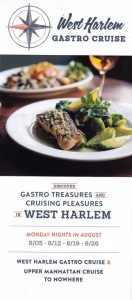
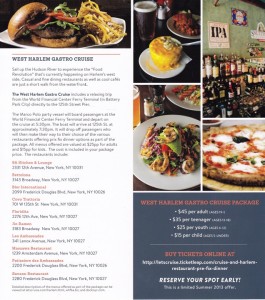
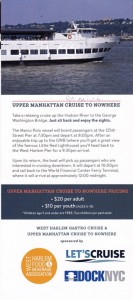
Enjoyed a great urban amenity this aft: NYC's Sheltering Arms public pool, Amsterdam&128th St. Clean, empty, lovely. pic.twitter.com/GloPoIheiQ
— Philip Turner (@philipsturner) August 13, 2013
This week has turned out to be a blend of some work combined with a supremely enjoyable Manhattan stay-cation. Yesterday, my wife and I got to swim at a neighborhood pool we’d never been to before, as the tweet above shows. Then today, with the temps in the mid-70s, we rode our bikes up along the Hudson to our favorite beauty spot, Hudson Beach, and then a few blocks further up-river to the Little Red Lighthouse, which nestles under the Great Gray Bridge, aka the George Washington Bridge. 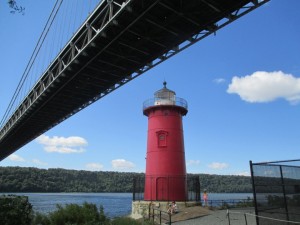
Like other great rivers such as the Chesapeake and the Columbia, the Hudson is a tidal body, flowing in to and out of the vast harbor of New York and what’s known as the Upper Bay. The tides make the Hudson ever-changing, one of the reasons it’s never boring to ride along its shore or study its contours. In moments of low tide, the shoreline will be exposed, leaving artifacts of NYC’s maritime past visible to the eye. Thus, times of low tide have made for very special rides in recent days and weeks. However, our ride today came at a time of high tide, as the pictures below will show. Moments of high tide make for a well-nigh overwhelming feeling of fullness, almost as if the river were in your lap as you gaze at it from the shore. High tide also brings a sense of the river’s prodigious power, as if one could practically be swept up in to it and borne away by its swells. That was the feeling we had today, almost as if we had made a visit to an ocean beach. Add to that feeling the fact that we rode more than nine miles in moderate temps under full sunshine amid brisk winds. The result was one of the best days of the whole summer 2013. Please click here to view all photos.
Gobsmacked–NYC Parks opens Little Red Lighthouse 2nd SAT each month so I just explored&walked up to its top deck pic.twitter.com/wMsKcoIGkV
— Philip Turner (@philipsturner) August 10, 2013
As readers of this blog will know, I admire the Great Gray Bridge, aka the George Washington Bridge–finding in it something like my own “beau motif (beautiful motif),” the words Cezanne used to describe Mont Sainte-Victoire, the Provencal peak he made the subject of at least 60 paintings. Not to liken my picture-taking or creativity to the work of the French master, but as I imagine MS-V was for him, the bridge is for me the ideal of an inexhaustible image. Much as my visual appetite thrives on it, I must add that I also admire its fated companion, the Little Red Lighthouse, an image of which from the time I began this blog I placed at the lower right corner on every page of the site. On the right-hand rail of the blog, under the heading “Foundational Posts” is a post I wrote early on called How This Blog Its Name, about these twinned NY landmarks.
If you’ve never had a close-up view of the two structures and aren’t certain where they are or how to see them for yourself, we’re talking about upper Manhattan on the island’s west side roughly level with what would be West 178th Street and the Hudson River. I get there on my bike, pedaling on good pavement along the river most of the way from my neighborhood around West 100th Street. The area can also be reached from Washington Heights, near 181st Street, and in both cases it’s accessible to walkers as well as cyclists. The forty-foot tall lighthouse–whose exterior is dotted with porthole windows and decked out in bright red enameled paint with a white cone and clear glass at the top–sits below the lower deck of the bridge, close to the monumental steel foot of the span’s eastern arch. According to a NYC Parks Dept web page, the two structures became most indelibly linked in the public imagination in the early 1940s, and even earlier in the city’s maritime history. Here’s a lightly edited version of the Parks Dept. article:
Here’s a lightly edited version of the Parks Dept. article:
“In the early 20th century, barge captains carrying goods up and down the Hudson demanded a brighter beacon. The [lighthouse] had been erected on Sandy Hook, New Jersey in 1880, where it used a 1,000 pound fog signal and flashing red light to guide ships through the night. It became obsolete and was dismantled [but not destroyed or discarded] in 1917. In 1921, the U.S. Coast Guard reconstructed this lighthouse on Jeffrey’s Hook [future site of the George Washington Bridge] in an attempt to improve navigational aids on the Hudson River. Run by a part-time keeper and furnished with a battery-powered lamp and a fog bell, the lighthouse, then known as Jeffrey’s Hook Lighthouse [the name since the early 1800s for the shelf of Manhattan schist that juts out in to the river right there], was an important guide to river travelers for ten years. The George Washington Bridge opened in 1931, and the brighter lights of the bridge again made the lighthouse obsolete. In 1948, the Coast Guard decommissioned the lighthouse, and its lamp was extinguished.
“The Coast Guard planned to auction off the lighthouse, but an outpouring of support for the beacon helped save it. The outcry from the public was prompted by the children’s book, The Little Red Lighthouse and the Great Gray Bridge, written by Hildegarde Swift and Lynd Ward in 1942. In the popular book, the Little Red Lighthouse is happy and content until a great bridge is built over it. In the end, the lighthouse learns that it still has an important job to do and that there is still a place in the world for an old lighthouse. The classic tale captured the imaginations of children and adults, many of whom wrote letters and sent money to help save the icon from the auction block.”
The Parks’ web page adds that in 1951 the Coast Guard gave the lighthouse and grounds to the City, and in 1979 the Little Red Lighthouse was officially added to the National Register of Historic Places. Refurbishments took place in 1986, when on the 65th anniversary the concrete foundation was restored, and in 2000 when it was repainted, true to its original shade of red.
In a real sense, the persistence of the lighthouse on the Manhattan shoreline is a product of one of the first episodes of “historic preservation” in the modern history of New York City. Too often, the city and posterity have been the loser in those battles, such as what ocurred in 1963, when–unaccountably to current-day New Yorkers–the old Penn Station was torn down. More recently, fixtures of the city’s industrial and maritime past other than the Little Red Lighthouse have been preserved, such as the old railroad car transfer at 60th Street and the Hudson, which I wrote about and photographed just a couple of days ago.
With all this as prologue, imagine my surprise yesterday when, on one of my bike rides up the Hudson to the bridge, on what turned out to be one of the most stupendously gorgeous days so far this summer, I suddenly spied people walking in and out of the lighthouse doorway–something I had never seen before! Seeing my surprise, a New York City Parks employee explained that in the warmer months, on the second Saturday of each month, they open the lighthouse to visitors. As I let down the kickstand on my old Trek and prepared to enter this maritime abode for the first time, another ranger in uniform greeted me and showed me and a second visitor a burnished brass key that she explained was for a long time used to open the lighthouse’s door. It was a chunky thing with big notches and looked like it weighed nearly a pound. In my eagerness, I neglected to take a picture of it, though I hope to do that the next time I visit, perhaps next month. Entering through the oval-topped door I found a nearly-dark chamber that looked like the lower decks of a ship or a submarine, with panels of thick riveted steel plates making up the walls. As I hope the pictures below help to show, the visitor encounters three spiral staircases with sturdy metal treads underfoot and a curved railing to help you climb up them. Between each flight of stairs, you can peer out the portholes that look south, toward lower Manhattan and Jersey City, and north, up-river toward Yonkers and the upper reaches of Palisade Park in New Jersey. Now, I’ll leave the rest of the storytelling to the photos I took and the captions I write for them. I invite you to visit the little red lighthouse and the great gray bridge for yourself. They are vibrant links to our not so-remote industrial and maritime past. Please click here to see the full photo gallery.
I’m beginning to add podcasts to The Great Gray Bridge, using audio clips I create myself. Perhaps later I’ll begin interviewing people and/or using audio sourced from elsewhere. My friend and Web guru Harry Candelario, designer of this whole website, has helped me set this up with Audacity software and a site called InternetArchive.org, where I created an account to turn sound files from my IPod Touch–such as this 2-minute tape made during a bike ride last year on the day before Christmas, on what felt like the windiest day of the season. I earlier covered the experience at this post with the photos I took and show it below in a screenshot–in to podcasts. I hope you enjoy this first one.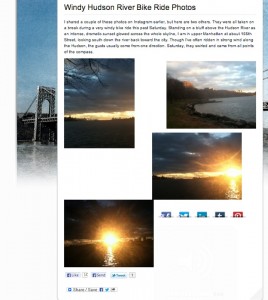
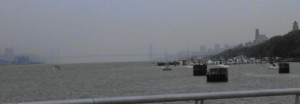 Kyle and I went for a nice bike ride late afternoon on Friday. It had been gray all day, and it rained a bit during our ride. That suited us fine as the light downpour made the bike paths in Riverside Park along the Hudson mostly empty. When we got out on the pier that projects out in to the river about even with 60th Street we stopped to look at the choppy water and took a few pictures.
Kyle and I went for a nice bike ride late afternoon on Friday. It had been gray all day, and it rained a bit during our ride. That suited us fine as the light downpour made the bike paths in Riverside Park along the Hudson mostly empty. When we got out on the pier that projects out in to the river about even with 60th Street we stopped to look at the choppy water and took a few pictures.
The one above shows the Great Gray Bridge looking northward in to the distant mist. The looming black structure behind me in a couple of the shots below is the old transfer station that was for many decades used to convey railroad cars that had first been barged from the New Jersey shore over to Manhattan and then on to the tracks of the old Penn Central or New York Central Railroad. At one time, a lot of the goods required by Manhattanites were brought on to the island this way. The transfer station has drawn our eye and lens for years, and we appreciate that it’s even still standing. At one point, odious Donald Trump, who was developing the apartment houses also seen in these shots, wanted to banish it from the river, but wiser heads prevailed, preserving a key link to our not so-remote industrial and maritime past.
Please click here to view all photos in this post.
